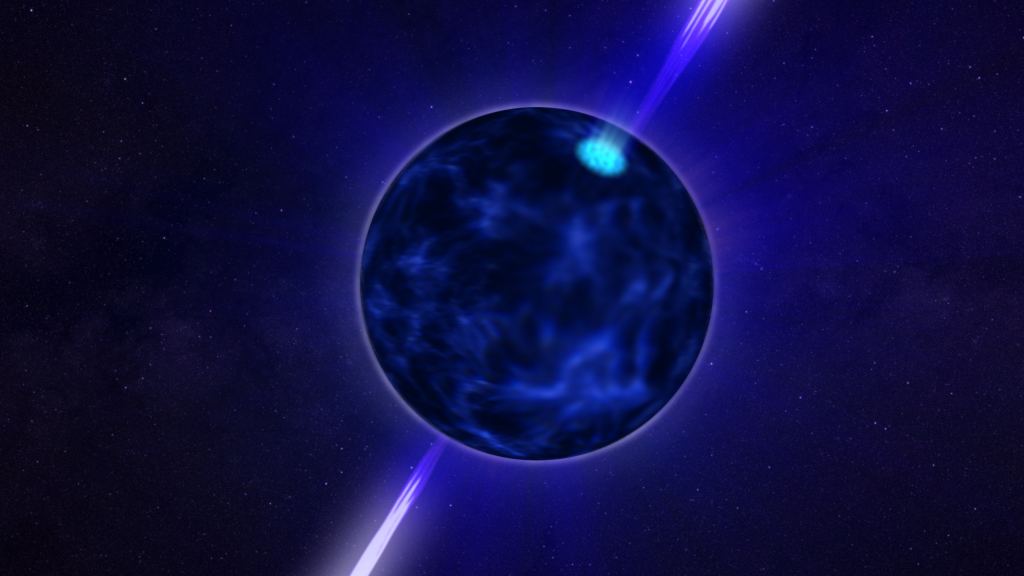Millisecond pulsars are amazing astronomical tools. They are fast-rotating neutron stars that sweep beams of radio energy from their magnetic poles, and when they are aligned just right we see them as rapidly flashing radio beacons. They flash with such regularity that we can treat them as cosmic clocks.
Any change in their motion can be measured with extreme precision. Astronomers have used millisecond pulsars to measure their orbital decay due to gravitational waves and to observe the background gravitational rumblings of the universe. They have even been proposed as a method of celestial navigation .
They may soon also be able to test the most fundamental nature of gravity. Since pulsars are the remnants of massive stars, our galaxy is likely to be filled with them. Although we have only observed about 2,000 pulsars thus far, it’s estimated that nearly a billion pulsars could exist in the Milky Way.
Right now they are just too faint for us to see, either because they are shrouded in dust, or are on the other side of the galaxy. But this means that there should be several pulsars in the central region of the galaxy, and a few of them could orbit our supermassive black hole, Sag A*. If we can observe millisecond pulsars closely orbiting Sag A*, we could test Einstein’s theory of general relativity in ways not currently possible.
The center of our galaxy is shrouded in gas and dust, but thanks to radio astronomy we can peer through the veil to see the region. We have long been able to see several stars orbiting Sag A*. By observing their motions over decades we have been able to confirm that general relativity holds true even in the strong gravitational fields near a black hole.
But our measurements aren’t precise enough to distinguish between the predictions of general relativity and rival gravitational theories. Although modified gravity models such as A QUAdratic Lagrangian (AQUAL) and Tensor–vector–scalar gravity (TeVeS) aren’t popular, they do agree with the stellar observations we have near our supermassive black hole. Remove All Ads on Universe Today Join our Patreon for as little as $3! Get the ad-free experience for life Millisecond pulsars would allow astronomers to measure orbital dynamics near Sag A* precisely, giving us a detailed view of how strong gravitational fields interact with mass.
It could provide experimental tests precise enough to distinguish between general relativity and other models. So a large team of astronomers has started to look for nearby millisecond pulsars in the data from the Event Horizon Telescope (EHT). Although the EHT collaboration didn’t release the first image of Sag A* until 2022, it has been gathering data on our supermassive black hole since 2017.
The observations don’t just contain the data for an image, they also contain observations of the surrounding area and things such as polarization of the radio light. If there are millisecond pulsars in the region, evidence for them could be buried in the EHT observations. However, because of the surrounding dust and the sensitivity limits of our observations, the signals would be very faint.
For this study, the team used three detection methods based on Fourier analysis, which is a mathematical technique that can detect patterns within data. Since pulsars emit regular pulses, they would tend to stand out against random noise. Unfortunately, the team didn’t find evidence for any new, previously unknown pulsars.
That isn’t too surprising given that even the team estimated the EHT data would be able to detect 2% of pulsars at best. And this is only a study of the first round of data. There is plenty more EHT data to examine, and EHT continues to gather data on the region.
Even if EHT hasn’t detected any pulsars, that doesn’t mean they aren’t there. Millisecond pulsars are almost certainly orbiting the Milky Way’s supermassive black holes, just like the stars we can currently see. It is only a matter of time before we find them.
Reference: Torne, Pablo, et al. “ A search for pulsars around Sgr A* in the first Event Horizon Telescope dataset . ” arXiv preprint arXiv:2308.
15381 (2023). .
From: universetoday
URL: https://www.universetoday.com/163012/astronomers-are-hoping-the-event-horizon-telescope-saw-pulsars-near-the-milky-ways-supermassive-black-hole/



